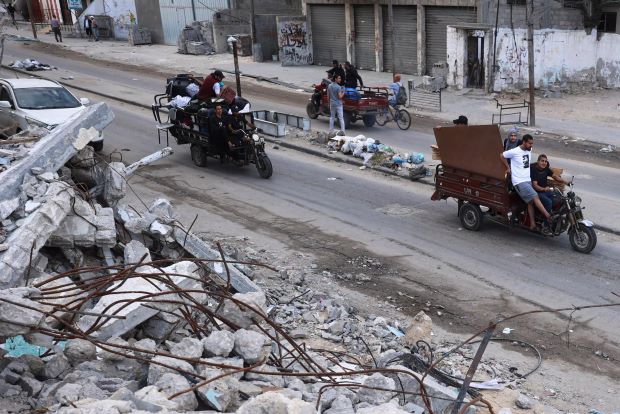Fierce fighting rocks Gaza after US warning of post-war ‘anarchy’
RAFAH – Israel battled Hamas in Gaza on Monday (13), including in far-southern Rafah, despite US warnings against a full-scale invasion of the crowded city and of the threat of post-war “anarchy” across the Palestinian territory.
Clashes also raged in northern and central areas of the besieged Gaza Strip, AFP correspondents and witnesses said, as Israel prepared to mark a sombre Independence Day, beginning Monday night, more than seven months into the war sparked by Hamas’s October 7 attack.
Israeli Prime Minister Benjamin Netanyahu told a Memorial Day event that “our war of independence is not over yet. It continues even today … We are determined to win this struggle”.
AFP correspondents reported helicopter strikes and heavy artillery shelling in the east of Rafah, as well as battles in northern Gaza’s Jabalia refugee camp and Gaza City’s Zeitun neighbourhood.
Israel last week defied international warnings, including from its top ally Washington, and sent tanks and soldiers into the east of Rafah, a city on the Egyptian border where some 1.4 million Palestinians had sought shelter.
This has sparked an exodus of nearly 360,000 people from Rafah so far, said the UN Agency for Palestinian Refugees UNRWA, which warned that “no place is safe” in the largely devastated territory.
US Secretary of State Antony Blinken said Sunday (12) that Washington had not seen any credible Israeli plan to protect civilians in Rafah, and that “we also haven’t seen a plan for what happens the day after this war in Gaza ends”.
“Israel’s on the trajectory, potentially, to inherit an insurgency with many armed Hamas left or, if it leaves, a vacuum filled by chaos, filled by anarchy and probably refilled by Hamas,” he told NBC.
Fighting has raged in northern Gaza where – months after Israel declared Hamas’s command structure had been dismantled – an Israeli army spokesman said there were “attempts by Hamas to rebuild its military capabilities”.
– Evacuation orders –
Hamas’s armed wing, the Ezzedine al-Qassam Brigades, also said that its militants were engaged in ground battles in Rafah and Jabalia.
A strike overnight on a house in Rafah killed at least four people, said the city’s Kuwaiti hospital which had received the bodies.
Rafah residents on Monday received more evacuation orders through phone calls and text messages, sending yet more people to start packing and leave their homes, witnesses said.
While Israel has vowed to destroy remaining Hamas forces in Rafah, the New York Times cited unnamed US officials as saying that both US and Israeli intelligence suggested the group’s leader Yahya Sinwar was not hiding there.
Sinwar – who has not been seen since the October 7 attack which Israel says he orchestrated – “most likely never left the tunnel network” under southern Gaza’s main city Khan Yunis, the Times said.
Amid the fighting, Egyptian, Qatari and American mediation efforts towards a truce appeared to have stalled.
UN chief Antonio Guterres urged on Sunday “an immediate humanitarian ceasefire, the unconditional release of all hostages and an immediate surge in humanitarian aid” into Gaza.
– Moment of silence –
As Israel marked its Memorial Day, sirens sounded across the country at 11 am (0800 GMT), prompting a two-minute silence in honour of fallen soldiers and civilian victims of attacks.
Memorial Day comes ahead of the country’s 76th Independence Day, beginning Monday at sunset, when Israelis celebrate the creation of their state in 1948.
Palestinians remember Israel’s establishment as the “Nakba”, or catastrophe, when hundreds of thousands of people were expelled or pushed out of their homes amid the war, and commemorate it annually on May 15.
The bloodiest ever Gaza war broke out after Hamas’s October 7 attack on Israel, which resulted in the deaths of more than 1,170 people, mostly civilians, according to an AFP tally based on Israeli official figures.
Militants also seized some 250 hostages, scores of whom were freed during a week-long truce in November. Israel estimates 128 captives remain in Gaza, including 36 who the military says are dead.
Israel’s bombardment and offensive in Gaza have killed at least 35,034 people, mostly women and children, according to the health ministry in the Hamas-run territory.
Israel’s military says 272 soldiers have been killed since the start of the ground offensive in Gaza on October 27.
– ‘We wish for death’ –
The war and siege have displaced most Gazans multiple times.
UNRWA chief Philippe Lazzarini said in a post on X on Sunday that Israel’s latest evacuation orders were “forcing people in Rafah to flee anywhere and everywhere”.
Umm Mohammed Al-Mughayyir, who has had to move her family seven times to escape the fighting, said: “We have reached a point where we wish for death.”
Residents were told to head to the Al-Mawasi “humanitarian zone” on the coast northwest of Rafah, though aid groups have warned it is not ready for an influx of people.
Hisham Adwan, spokesman for the Gaza crossings authority, told AFP on Sunday the Rafah crossing with Egypt has remained closed since Israeli troops seized its Palestinian side on Tuesday, “preventing the entry of humanitarian aid”.
The health ministry said Monday that Gaza’s health system is “hours away” from collapse after fighting has blocked fuel shipments through key crossings.
Israel’s military said Sunday it had opened a new border crossing into northern Gaza as “part of the effort to increase aid routes”.
In a sign of growing regional tensions, Egypt – the first Arab nation to sign a peace treaty with Israel, in 1979 – said it would formally support an International Court of Justice case brought by South Africa, accusing Israel of genocidal acts in the war.
– Agence France-Presse



Comments are closed, but trackbacks and pingbacks are open.